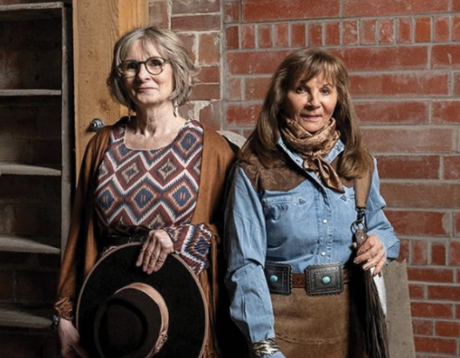Alberta’s Legendary Cowboy
 |
| Rancher Jack Morton wearing woolly chaps while on horseback somewhere in the Standard area, Alberta, ca. 1920s. The fancy martingale on the horse is made from rings and spacers more commonly used to make “spreaders” used between a team of horses to allow them to walk (or in Morton’s case, probably run) further apart. Photo courtesy Glenbow Museum Archives |
“Wild Horse” Jack Morton was literally larger than life; a towering giant of pure muscle and mischief. He loved horses and wasn’t particular whose brand it wore. It’s said he stole as many horses as he bought, but he also gave away as many horses as he rounded up, outfitting homesteaders with not only teams but often a wagon, harness and a milk cow to feed the kids. When the homesteader came to repay the debt, Morton had often lost the promissory note and forgave the debt. But if a man reneged on a deal Morton would simply steal his horses back.
He grubstaked more cowboys and homesteaders and provided more entertainment and bedevilment to the courts and police than any other man in Alberta. He was called the Robin Hood of the Plains and today, literally thousands of descendants of pioneers owe their families survival to the generosity of Jack Morton.
Born in 1883 in Balmoral, Man., John “Jack” Charles Morton was the fourth son of Saville and Maria Morton, who immigrated to the Canadian West from Devonshire, England. From his father Jack inherited his great love of horse racing. Saville would organize a race at the drop of a hat, and a neighbour once told about a local funeral procession that deteriorated into a free-for-all race as mourners, who were also drivers, forgot their solemn reason for being on the trail.
Growing up, Jack spent more time playing mischievous pranks than doing schoolwork, so with a Grade 3 education he left school and began training horses. His greatest interests in life were cattle, horses and just like his father, horse racing.
He cowboyed for a few local ranchers and eventually found work at the Winnipeg stockyards. It was here in 1900 he hired on with Jose Sala, a France-raised Spaniard who had purchased a ranch site in the Rosebud Valley north of Gleichen, Alberta.
Jack’s knowledge of cattle and abilities with horses allowed them both to prosper and Jack began building his own herd with his CX brand. He proposed to Sala’s daughter, Carmen, but her mother was against the union. Her brother helped her escape out a window and she and Jack eloped in the deadly spring of 1903 that wiped out over 40 percent of the cattle from the Red Deer to the Missouri River.
Cattlemen were discouraged, but with settlers pouring in and cavalry remounts needed for the Boer War, horsemen like Jack Morton answered the call. When he started to run out of horses he began breaking oxen, but like his horses, his idea of broke and a settler’s idea were often two different things.
The Salas sold their holdings to Morton and Jack began building up the CX Ranch, purchasing the Bragg Ranch northwest of Standard, the XC southwest of Cochrane, the Pacific Cold Storage Ranch northeast of Standard and a huge tract of land northeast of Hussar called the Indian Springs farm. In a mere decade from 1909, he increased his land holdings from a settler’s quarter section to nearly fifteen thousand acres of crop and grazing land. The ranch he wanted most was the Two Bar, big enough to support ten thousand head. He closed that deal in 1919.
 |
| Jack Morton and his children, Frances, Charlotte, Clare, Alan and Lucy (leading) at the Pacific Cold Storage ranch, Standard area, Alberta, 1920 Photo courtesy Glenbow Museum Archives |
Morton was famous for being fearless and would hitch a team that had never seen harness and head for town. Once they quit their panicked headlong flight he would pronounce them “tame as kittens” and go get another team. Jack made so many horse deals that men would start out in the field with a hitch of four and by noon, Jack would have sold them, and replaced them with four more. Settlers flocked to the Two Bar to buy horses and if they had money, he’d take it, and if they didn’t, they got their horses anyway, with or without signing a note.
Morton also loved rodeo and enthusiastically supplied stock, competed in wild horse racing, wild cow milking, cart races and was one of the founders of the Gleichen Stampede. Guy Weadick recruited Jack to provide colour and excitement to the Calgary Stampede in 1923 and it was Jack who Weadick credited with creating chuckwagon racing. It was also Jack Morton and his crew of cowboys from the CX Ranch that started Calgary’s traditional pancake breakfasts. Jack’s were a bit more entertaining than today though, as his horses were snuffy and he went everywhere accompanied by two badgers that were anything but tame.
His generosity, and flair for making money but not saving any caught up with him and in 1926, Jack’s lands and horses were seized by the banks. Not all were gathered and for years after, CX horses were appearing and multiplying, and drifting west to join the wild bands.
Morton said he wanted to die in his own saddle and in a sense he did. Riding in the Strathmore district at night he suffered a massive stroke. He was hospitalized until a final stroke ended his life on August 9, 1944. He is buried in the Gleichen United Church Cemetery.
Perhaps the late Grant MacEwan described Morton best when he wrote:
“Morton never aspired to own more horses than any other person in Canada — but he did, and everyone that ever knew the big cowboy had a superlative for him — toughest, most fearless, generous or the strongest man I ever knew.” Anybody looking for saintliness would have been disappointed, but if charity covers a multitude of sins, Jack Morton will emerge spotless.
Pull quote:
… if a man reneged on a deal Morton would simply steal his horses back.














